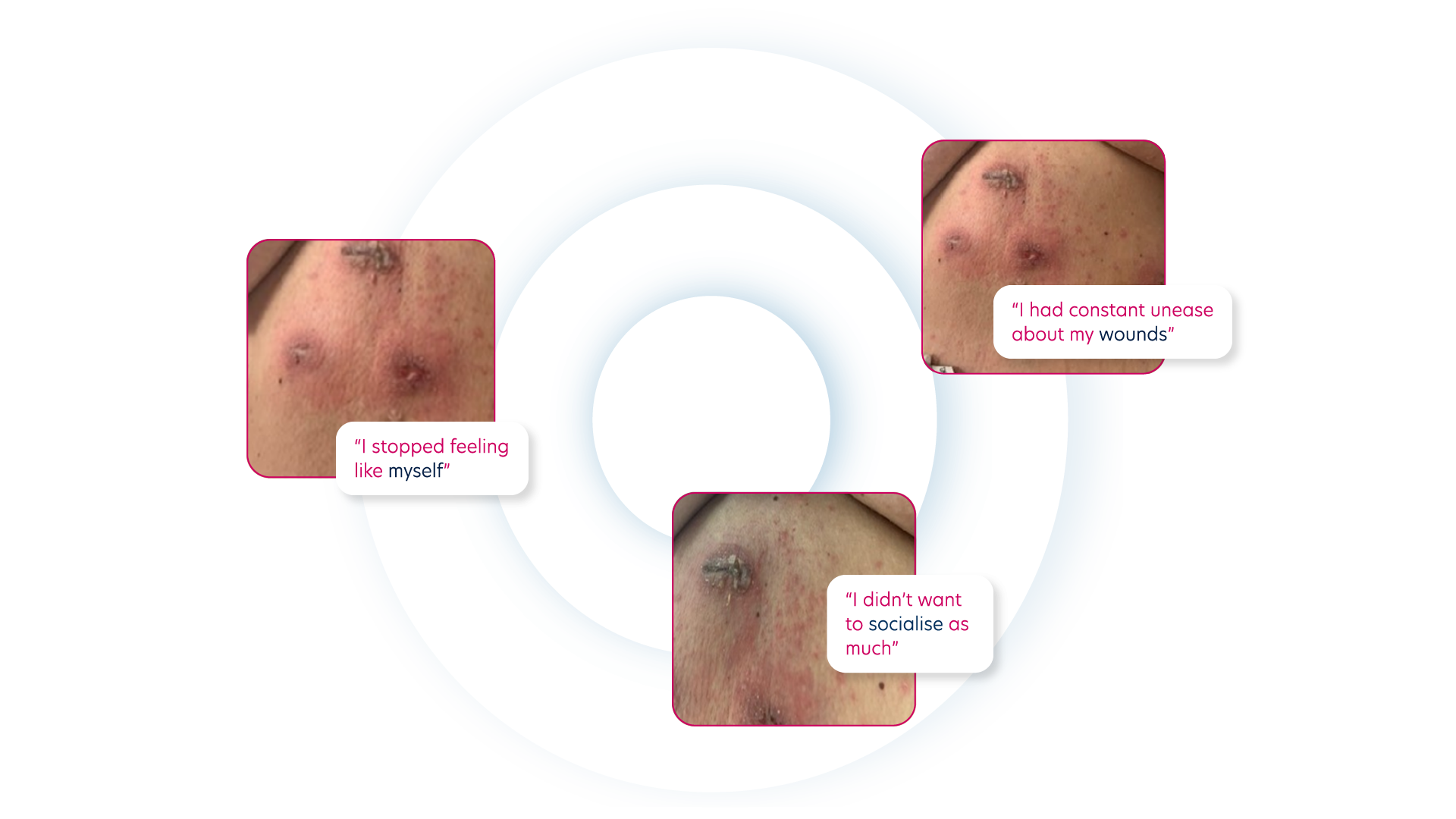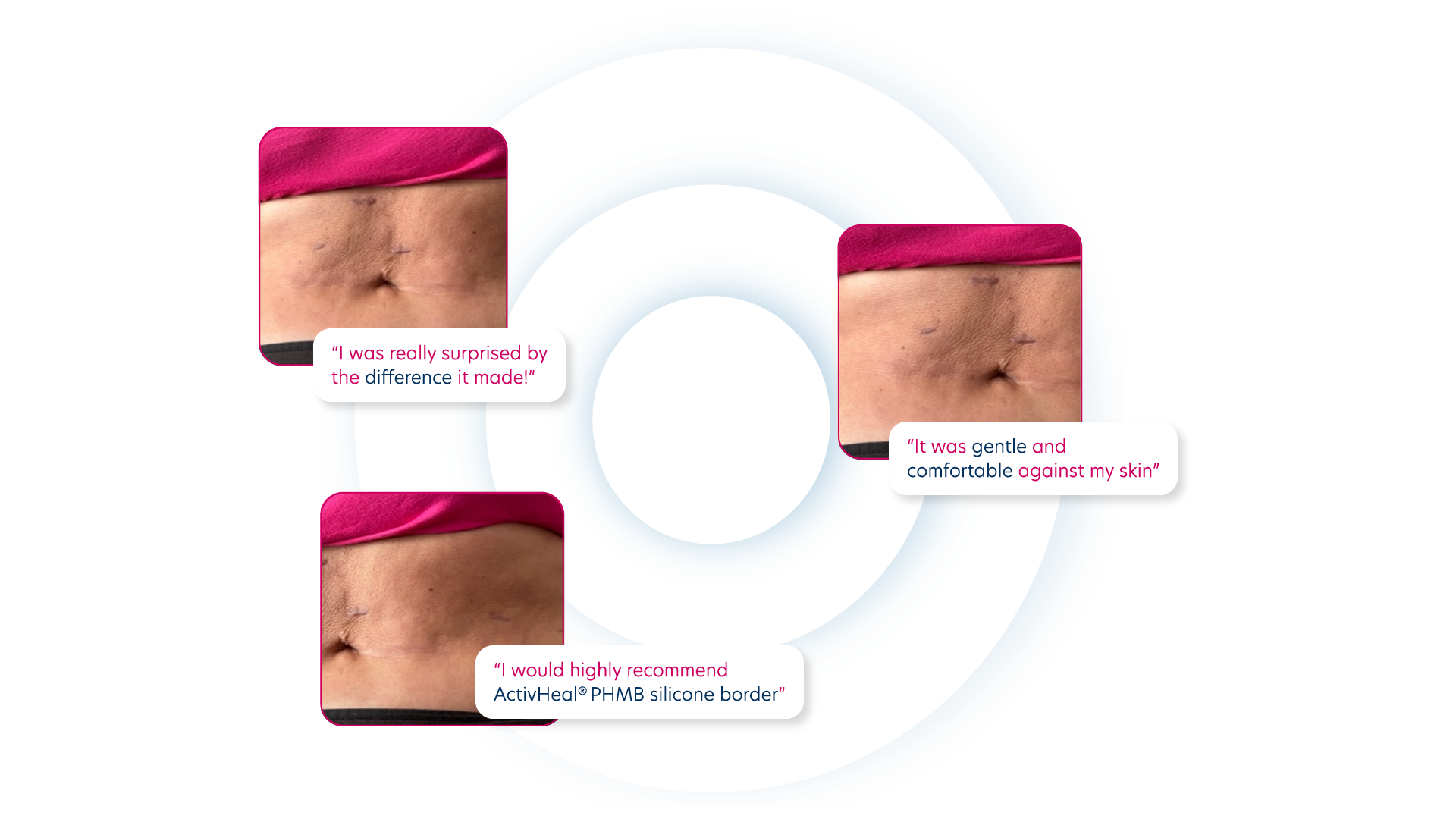Watch the full interview
Introduction
Living with a wound can have a profound impact on a person, their family and lifestyle. This testimonial highlights the effects of a delayed healing wound. The use of ActivHeal® PHMB Foam Silicone Border, from the perspective of the individual. Tracy has kindly shared her story and the affect a postoperative wound had on her life.
Background
Tracy is in her early 50’s, married, working full time in a demanding job, and running a small business with her husband. She is independent, active, socially outgoing with a love of travel. Her wound story starts with a routine fundoplication surgery, (an operation to correct gastro- oesophageal reflux).
The operation was carried out laparoscopically which resulted in 5 entry/ exit sites post operatively. She left hospital as expected, with basic, but adequate, simple island dressings in place.
Tracy’s wound journey
“After coming home, everything appeared to progress as I had expected. I was informed that there would likely be some discomfort, due to the nature of the procedure. I showered after 24hrs and then changed the dressings over my operation sites. I continued to recover, but the tenderness was still there days later.
Initially I dismissed it as part of the healing process, but when I checked my abdomen, my wounds were redder than before, feeling warmer to the touch and there was a noticeable discharge. I cleaned them and used basic dressings that I had to hand. Over the following days there was no noticeable improvement, in fact the wound sites were getting worse, to me, they looked dirty and wet. Concerned I contacted my local surgery for advice, and I was given an adhesive foam dressing to cover the areas and manage the discharge.
I tried to carry on as usual, but this was easier said than done. My confidence to wear my normal clothes was affected due to worrying the wound fluid would leak through and stain. I did not want to socialise as much, I felt that the wound odour I could smell would be picked up by those around me. My general routine was interrupted, and I had a constant unease about my wounds. I stopped feeling like myself.
I was not seeing any improvement and felt, from further research on wounds, that mine were infected and the tissue around was grey/brown (sloughy). This was making my healing process even more daunting.

At this point I spoke to a friend who I knew had a wound care background and sent pictures of my wounds.
They agreed that they looked infected and suggested that I would require some sort of antimicrobial dressing to stop this and to address the sloughy tissue, exudate, and odour. They also advised seeing a healthcare professional. Whilst I was waiting to see the latter, I was given some ActivHeal® PHMB Foam Silicone Border. To be truthfully my expectations were low as the previous foam dressing had not made an impact, however I was really surprised the difference it made!
To start with it was gentle and comfortable against my skin, meaning I could wear it for long periods without any discomfort. I had no anxiety over leakage as it felt securely adhered to my skin. In a very short period, my wounds showed visible signs of improvement, the redness and swelling were reduced, the foul odour disappeared, with the sloughy tissue diminishing. I decided to continue with ActivHeal®. My wounds continued to heal, most importantly to me, the sloughy tissue was being replaced by healthy pinky- red (granulation) tissue.
This progress, I felt, it was nothing short of a miracle, and I credit it all to ActivHeal®.

I cannot emphasize enough how this product proved to be exceptionally effective in promoting healing and providing the necessary protection and comfort I, and my wounds required.
Prior to my procedure, I would never have thought the extent and effect a wound could have on my life. I would highly recommend ‘ActivHeal® PHMB Silicone Border’ to anyone in need of effective wound care. It made a significant difference in my healing journey, and I believe it can do the same for others.”
TIME TO THINK POSITIVELY ABOUT INFECTED WOUNDS
Approximately 4-5% of the adult population are estimated to have a chronic/ non-healing wound at any given time, which poses a significant burden to healthcare systems¹.
These type of wounds can also cause considerable discomfort and negatively impact a patient’s quality of life, potentially leading other problems such as sleep disturbance. Additionally, dressing changes can be particularly painful as the wound site is often tender. Chronic/ non healing wounds, if left unchecked, are a higher risk for infection, which is not treated can lead to serious infections such as septicaemia and can even be fatal². Timely individual and wound assessment in conjunction with effective treatment of wounds, can prevent deterioration and improve healing and patient wellbeing.
ActivHeal® PHMB Foam Silicone Border, a highly effective, fast-acting antimicrobial can assist with wound progression and may help to improve outcomes and quality of life for patients.
- Reduces wound pain during wound healing – by managing wound exudate and microbial contamination
- Effective against gram negative, gram positive and yeast³ - kills and inhibits the growth of bacteria and prevents colonisation and proliferation of bacteria
- Perforated wound contact layer with a gentle silicone adhesive film – protects the wound bed from adhering to the dressing
- Supports non traumatic removal – assists with minimising trauma at dressing change
- Faster log reduction than silver foams⁴- 8x faster (99.99%), against MRSA, MRSE and E.Coli
- Absorbency - helps to manage exudate and minimise the risk of maceration and leakage
Tracy’s journey and testimonial highlights the potential use of ActivHeal® PHMB Foam Silicone an effective wound care solution for all stages of wound healing.
Start your free trial now!
*Tracy would like to express her gratitude to Karen Davey @ ActivHeal® - for her support, compassion, and care.
References
- Guest JF, Ayoub N, McIlwraith T, Uchegbu I, Gerrish A, Weidlich D, Vowden K, Vowden P. Health economic burden that different wound types impose on the UK’s National Health Service. Int Wound J. 2017 Apr;14(2):322-330.
- Newton, H. (2010) Reducing MRSA bacteraemias associated with wounds. Wounds UK 6 (1): 56-65.
- Data on file P3747R, P3749R.
- Data on file. Lab data 6317, 7541.